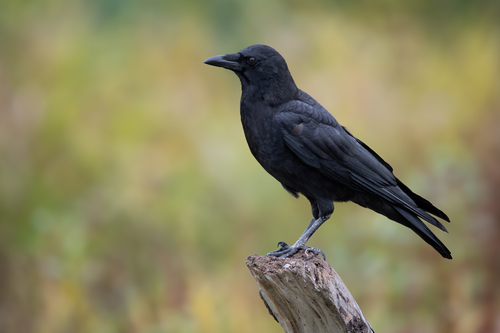
American Crow
The American Crow (Corvus brachyrhynchos) is a highly intelligent and adaptable bird species widespread across North America. Known for their distinctive 'caw-caw' calls, these birds play a significant role in various ecosystems, acting as scavengers, predators, and seed dispersers. They are also culturally significant, often appearing in folklore and literature, sometimes symbolizing intelligence, adaptability, or even as omens. Their ability to solve complex problems and recognize individual human faces has fascinated researchers and bird enthusiasts alike.
40-53 cm
Length
85-100 cm
Wingspan
Least Concern
Conservation Status
Distribution
The American Crow is found throughout North America, from Canada to northern Mexico. They are absent from the extreme Arctic regions and some parts of the southwestern desert. Some populations are migratory, with northern birds moving south for the winter, while others are year-round residents.
Lifespan
In the wild, American Crows typically live 7-8 years, although some individuals have been recorded living much longer (up to 14 years). In captivity, they can live even longer.
American Crow's Habitat
Habitat Types
Open woodlands, Farmlands, Urban areas, Suburban areas, Forests, Grasslands, Coastal areas
Climate Zones
Temperate, Subtropical, Boreal
Adaptations
American Crows are highly adaptable to a wide range of habitats. Their generalized diet and opportunistic foraging behavior allow them to thrive in diverse environments. They are also behaviorally flexible, adjusting their social structure and nesting habits based on resource availability and human presence.
Variations
Several subspecies are recognized, differing slightly in size and vocalizations. For example, the Northwestern Crow (*Corvus caurinus*) is sometimes considered a separate species, but is increasingly treated as a subspecies of the American Crow.
Appearance
Breeding Plumage
Plumage is generally consistent throughout the year.
Seasonal Feather Changes
Slight wear and fading may occur, but no distinct seasonal changes.
Sex Based Plumage Differences
Males and females have similar plumage, appearing entirely black with a slight iridescent sheen.
Notable Features
Strong, black bill, Black legs and feet, Iridescent black plumage, Fan-shaped tail
Diet and Feeding
Primary Foods
Insects, Seeds, Grains, Fruits, Nuts, Carrion, Small animals (e.g., mice, frogs), Bird eggs and nestlings, Human garbage
Foraging Behavior
American Crows are opportunistic omnivores and forage in a variety of ways. They often walk on the ground, probing for insects and seeds. They also cache food, hiding it in various locations for later retrieval. They are known to use tools, such as sticks, to extract insects from crevices.
Specializations
Their strong bill is adapted for a wide range of food items, allowing them to crack nuts, probe soil, and tear carrion. Their intelligence and adaptability are key to their foraging success.
Seasonal Diet Variations
Diet varies seasonally depending on food availability. In winter, they may rely more on grains, nuts, and carrion. During the breeding season, insects and other protein-rich foods are important for feeding young.
Behavior
Social Structure
American Crows are highly social birds. They often form large family groups, and outside of the breeding season, they may gather in large communal roosts, sometimes numbering in the thousands or even millions of birds.
Communication
A wide variety of vocalizations, including the familiar 'caw-caw', Body postures (e.g., bowing, wing-flapping), Facial expressions (e.g., raising or lowering head feathers)
Migration
Some populations are migratory, while others are resident year-round. Migratory crows typically move south in the fall and return north in the spring. Migration patterns can be complex and vary depending on location and food availability.
Territorial or Group Behaviors
During the breeding season, family groups defend territories around their nests. Outside of the breeding season, they are highly social and often forage and roost together in large groups.
Conservation
Threats
Habitat loss (although they adapt well to human-altered landscapes), Pesticide exposure, Persecution (historically, due to perceived damage to crops), West Nile Virus (a significant cause of mortality in some areas)
Protection Programs
The Migratory Bird Treaty Act (in the US) protects American Crows., Monitoring programs track population trends and disease outbreaks.
Local National Laws
Protected under the Migratory Bird Treaty Act in the United States.
Population Trend
Stable
Population Estimates
The global population is estimated to be around 27 million individuals.
Interesting Facts
American Crows can recognize individual human faces.
Research has shown that crows can remember the faces of people who have threatened them and will scold them even years later.
They are known to use tools.
American Crows have been observed using sticks and other objects to extract food from hard-to-reach places.
They hold 'funerals' for dead crows.
When a crow dies, other crows will often gather around the body and vocalize, possibly to learn about potential dangers.
They form large communal roosts in winter.
These roosts can contain thousands or even millions of birds, providing warmth and protection from predators.
Young crows often stay with their parents for several years.
These 'helpers' assist in raising subsequent broods, gaining valuable experience before breeding themselves.
Faqs about American Crow
Are American Crows harmful to crops?
While crows can sometimes damage crops, their impact is often overstated. They also consume large numbers of insects and other agricultural pests, providing a beneficial service.
Do crows attack people?
Crows rarely attack people, but they may become aggressive if they feel threatened or if their nest is disturbed. It's best to avoid approaching crow nests.
What should I do if I find an injured crow?
Contact a local wildlife rehabilitator or veterinarian. It is illegal to possess or harm wild birds without the proper permits.
How can I tell the difference between a crow and a raven?
Ravens are larger than crows, with a heavier bill, a shaggy throat, and a wedge-shaped tail. Ravens also have a deeper, croaking call compared to the crow's 'caw-caw'.
Why do I see large groups of Crows together?
Outside of breeding season, Crows often gather in large groups called "roosts". These roosts can number from a few dozen up to even a million birds. Roosting offers safety, communal warmth, and information exchange about food sources.
Copyright @ Nature Style Limited. All Rights Reserved.
 English
English